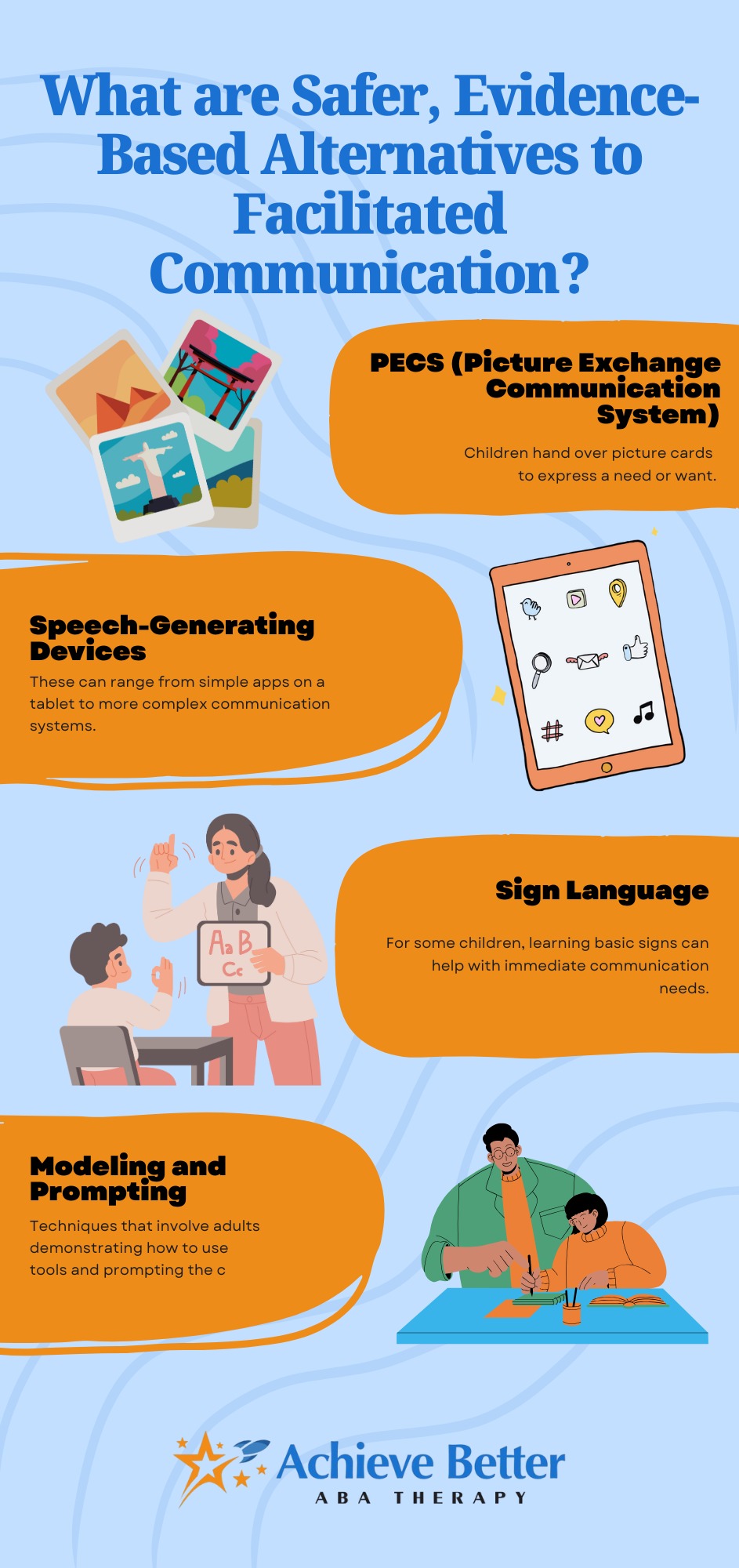Autism and Facilitated Communication: Understanding the Technique

Key Points:
- Facilitated communication (FC) is a method intended to help individuals with autism communicate by typing or pointing with support.
- The technique is highly controversial, with limited scientific support, but some families report meaningful breakthroughs.
- Understanding autism requires a thoughtful, balanced look at communication tools and evidence-based therapies like ABA.
You’ve probably had a moment where you just knew what your child was trying to say, even when no words came out. For many parents of children with autism, that moment becomes a daily reality—one filled with love, guesswork, and the deep desire to truly connect.
Is Facilitated Communication a Reliable Way for Autistic Individuals to Express Themselves?
No—facilitated communication (FC) is not considered a scientifically reliable method, though it remains emotionally significant to some families. Autism facilitated communication, sometimes shortened to FC, is a technique developed in the 1980s that involves a trained “facilitator” supporting the hand, arm, or shoulder of a non-verbal person as they type or point to letters, words, or symbols.
This method emerged from a hopeful place—a desire to break through the wall of silence that often surrounds non-speaking individuals with autism. Over the years, some parents and caregivers have described moving, seemingly authentic interactions that occurred using FC. But as we’ll see, the scientific community has approached this method with serious caution, and the debate remains complex.
What is Facilitated Communication?
Facilitated communication is based on the idea that some individuals with autism have intact cognitive abilities but are unable to express themselves due to motor challenges or sensory issues. The facilitator provides physical support, usually at the hand, wrist, or elbow, and the individual is encouraged to type or point to communicate.
The intention behind autism facilitated communication was compassionate: to give a “voice” to those who couldn’t speak. FC started gaining traction in the 1990s when some practitioners believed it unlocked communication in ways that traditional speech therapy had not. But as the technique spread, questions began to arise. Critics wanted to know—who was really doing the communicating?
Why is Facilitated Communication Controversial?
Though FC was welcomed with hope, it was met with growing scrutiny. Multiple controlled studies began testing its effectiveness, and the results were troubling. When facilitators didn’t know the answer to a question or weren’t in on the message, the responses often didn’t make sense—or didn’t happen at all.
Facilitated communication has been criticized primarily for one central concern: It’s often unclear whether the messages are coming from the individual or from the facilitator—consciously or unconsciously.
Some key points of criticism include:
- Lack of Independent Verification: In studies where the facilitator was unaware of the prompt or question, the user often could not provide accurate answers.
- Legal and Ethical Risks: There have been cases where messages typed through FC led to false allegations, leading to major consequences.
- No Consistent Scientific Evidence: Major organizations, including the American Psychological Association, do not support FC as a valid communication method.
Despite these concerns, some families continue to report that FC has helped them connect with their loved ones in meaningful ways. This emotional pull makes the topic a particularly difficult one.
How Do Families Use Facilitated Communication Today?
Even with the controversy, some parents and caregivers explore FC in the hopes of helping their child be heard. It’s often used alongside other forms of augmentative and alternative communication (AAC), such as speech-generating devices or picture exchange systems.
While not scientifically endorsed, FC may offer the following perceived benefits to some families:
- Connection: Even the act of trying to communicate can deepen the parent-child bond.
- Hope: For some, FC represents a chance to discover untapped abilities.
- Emotional Relief: When a message—real or perceived—comes through, it can bring powerful emotions.
It's important, though, to proceed with caution and to stay informed about what research supports and what it does not.
What are Safer, Evidence-Based Alternatives to Facilitated Communication?
If you’re seeking ways to help your child with autism communicate, you’re not alone—and fortunately, there are well-supported, science-based tools to explore. Many of these methods fall under the umbrella of AAC and have helped thousands of children make real progress.
Here are a few commonly used and supported alternatives to facilitated communication:

These methods are often combined with ABA therapy, which is an evidence-based practice aimed at improving communication, social skills, and behavior.
How Does ABA Therapy Support Communication?
Applied Behavior Analysis (ABA) therapy is one of the most researched and widely endorsed interventions for children with autism. While it doesn’t directly replace FC, it provides a structured, individualized approach to teaching communication and life skills.
ABA therapy helps children with autism build functional communication by:
- Breaking down communication into teachable steps.
- Reinforcing successful attempts to express needs and wants.
- Using tools like visual aids, token systems, and naturalistic teaching.
- Encouraging independence in verbal and non-verbal expression.
If your child is struggling to communicate, ABA offers strategies that are tailored, practical, and backed by decades of research.
A Compassionate Path Forward
If you’ve felt caught between hope and uncertainty when it comes to autism facilitated communication, you’re not alone. The desire to understand and connect with your child is one of the most powerful forces there is.
As tempting as FC may seem, it’s essential to balance emotional instinct with scientifically supported options. There's no one-size-fits-all solution, but there are effective, compassionate therapies that help children make meaningful progress—especially when guided by professionals who understand the unique journey of autism.
Ready to Help Your Child Communicate and Thrive?
If you’re looking for proven support to help your child grow in communication, social skills, and independence, Achieve Better ABA is here for you. We specialize exclusively in ABA therapy in North Carolina, focusing on evidence-based strategies that are tailored to your child’s needs.
Our dedicated team is passionate about helping children with autism develop practical, lifelong skills. ABA therapy can provide real, measurable results—especially when started early and guided with care.
Don’t wait to take the next step toward meaningful connection and growth. Get in touch with us today. Let’s work together to help your child thrive.
Similar articles
Contact us today to learn more.




.jpg)

.jpg)





